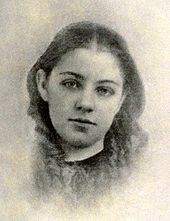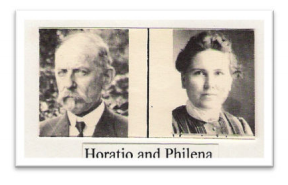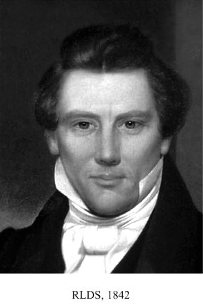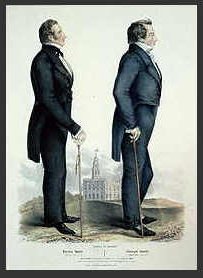Who’s
Who in the William Pickett Family
Agnes
M. Coolbrith Smith Pickett and Susanna M. Rogers Sangiovanni
Pickett and their blended families.
Compiled and with notes by Merridy Jeffery
------------------------
From Cowans Auctions
2006 Listing-------------------------------
Portrait of Two Identified Mormon Children
www.cowansauctions.com
archives.
ca 1847, oil on canvas,
unsigned. A charming portrait of two children —the boy is seated
on a bench beside a trellis covered with grapevines, peeling a piece
of fruit, and the girl is kneeling beside him, holding a small bunch
of grapes, her left hand outstretched to accept a piece of the
peeled fruit. In the background is a river landscape with a wagon
train, an allegorical element commonly found in contemporary and
historic Mormon art. In its original, gilt frame; 38” x 31”
(w/o frame), 44.5” x 37.5” (w/frame).

An old paper
label tacked to the back of the frame reads GGR Sangiovanni
Deadwood So Dak, and the lot is accompanied by an 1821 Italian
bible that is inscribed Susanna M. Sangiovanni A Present From
Mrs. Rossetti March 1890 along with two manuscript letters: one
providing the history of the bible’s ownership; another, a brief
statement concerning GGR Sangiovanni’s birth and ancestry. The
letter specific to the bible bears an additional ink signature by
Sangiovanni, notarized by a Deadwood notary in 1908. That signature
and the label attached to the painting appear to be by the same hand
and from about the same period.
Genealogical research in
conjunction with information gathered from LDS Church archives
suggest that the two subject children are Guglielmo Giosue Rossetti
Sangiovanni and Agnes C. Smith, painted in St. Louis, Missouri, ca
1847.
Guglielmo Giosue Rossetti (Sanjo) Sangiovanni
(1835-1916), the only child from the marriage of Benedetto
Sangiovanni and Susanna Mehitable Rogers, was born in London.
Susanna was the oldest of eleven children born to David White Rogers
and Martha Collins, both early Mormon converts. Martha was running
a rooming house in the Battery section of New York when Susanna met
Benedetto in 1833. Benedetto, an Italian Revolutionary in exile,
sought accommodations at the rooming house where he became attracted
to Susanna, persuaded her to marry him and took her to London in
search of a better life. There they had a son, nicknamed Sanjo.
Susanna was happy enough early in her marriage, but she
grew to fear her husband because he was jealous of the attention she
paid to their son. She also believed that he had not abandoned his
revolutionary activities. About this time, she and Sanjo were
secretly baptized by Mormon missionaries, and shortly thereafter,
with the help of these missionaries, she and her son fled England,
leaving Benedetto behind. The missionaries had instructed her to
take a train to Liverpool, where she could then get passage to New
Orleans. Susanna and Sanjo arrived in Louisiana in 1846, and they
then made the journey up the Mississippi River to Saint Louis.
While in Saint Louis, Susanna became a plural wife of
William Pickett, who has been described as a “lukewarm” Mormon.
When Pickett had learned that Susanna was pregnant, he left them
[Susanna and Sanjo], moving to California with his other wife, Agnes
Coolbridge [Coolbrith] Smith, their twins, and Agnes’ children
from her first marriage. Pickett later became an alcoholic and
abandoned his family in 1870. Susanna’s son, Horatio, was born in
1848. She and her two sons then moved west, to Utah, in 1852, to be
near her family.
Agnes C. Smith (1836-1873), eldest
child from the marriage of Don Carlos Smith and Agnes [Moulton]
Coolbrith, was born in Kirtland, Ohio. Don Carlos was a brother of
Joseph Smith, founder of the LDS Church. She and Don Carlos had
three children (Agnes in 1836, Sophronia in 1838, and Josephine in
1841), two of whom lived to adulthood. After Don Carlos’ death in
Nauvoo, Illinois in 1841, Agnes Coolbrith married Joseph Smith, a
marriage that was kept secret. After his assassination in 1844, she
married to George A. Smith, a cousin of Joseph and Don Carlos. She
did not, however, follow Smith west to Utah, and in the spring of
1847, she became the plural wife of William Pickett, and they moved
to Saint Louis. About 1848, shortly after the birth of twins,
Pickett, his wife and all of the children left the Mormon Church
(and Susanna and Sanjo) and migrated to California.
Based
on this information, for a relatively short period in Saint Louis in
1847-1848, during the period of the plural marriage between Pickett,
Agnes Coolbrith and Susanna Sangiovanni, the children born of Agnes
Coolbrith and Don Carlos Smith were living in the same household
with Susanna’s son, Sanjo. Also during this time period, Agnes and
William’s twins were born [William, Jr and Don Carlos, Jr], and
just after this household broke up, Susannah gave birth to Horatio.
Within this polygamous household, the two oldest children were Sanjo
and Agnes, who were both between eleven and thirteen years of age.
Although the children in the portraits look to be slightly younger,
these two are the most likely subjects of the portrait offered here.
Sangiovanni was a very active young man and faithful to
his church. According to manuscripts located in the University of
Utah Marriott Library, specifically the Eleanor C.W. Jarvis Diary
and Autobiography, he taught school at the Dixie Cotton Mission
at St. George, Utah in the winter of 1868 and 1869. He moved to
Salt Lake City around 1870, married to Mary Ann Brown, and fathered
two daughters. It is recorded in The History of Museums in Utah
that he became the first caretaker of the Deseret Museum located in
Salt Lake City, which is currently known as the LDS Museum of Church
History and Art. Apparently, sometime after 1873, Sanjo had lost
the faith and moved his family to Deadwood, South Dakota (then the
Dakota Territory), where he became a saloon-keeper. Mary Ann died
in Deadwood in 1886. According to the notarized letter included
with this lot, Sanjo remained in Deadwood until at least 1908, but
sometime before his death in 1916, he returned to Utah. He is
buried at Mount Olivet Cemetery in Salt Lake City.
Since
the tag on the frame indicates that Sanjo owned this portrait late
in life (having taken it from Utah to Deadwood), and since,
stylistically, the portrait dates to the 1840s, it is almost certain
that Sanjo is the boy portrayed, and thus the girl is very likely
little Agnes, the niece, and step-daughter of LDS founder, Joseph
Smith.
Extensive genealogical and historical research
accompanies the painting which supports the identification of the
children.
Condition: Recently
conserved, report available.
-
- - - - - - - - - - - - - - - - - - - - - - - - - - - - - - - - - - - - - - - -
- - - - - - - - - - - - - - - - - - - - - - - - - - - - -
May
2017 –– Notes
by Merridy
Jeffery, g-g-grand-daughter of Susanna Mehitable Rogers
Sangiovanni Pickett. I am not a descendant of either one of these
children, but descend through her other son, the Horatio Pickett
line., g-g-grand-daughter of Susanna Mehitable Rogers
Sangiovanni Pickett. I am not a descendant of either one of these
children, but descend through her other son, the Horatio Pickett
line.
This
William/Agnes family
has been a little confusing to make sense of since Agnes’s
full name (the mother) would be Agnes Moulton Coolbrith Smith Smith
Smith Pickett
– and this Cowans
story sets the record
straight, showing
that Josephine was
not a daughter of Susanna
as is sometimes
erroneously stated. Nor
was she the daughter of Wm Pickett, but his step-daughter.
According to her wiki
page, she was
the first Poet Laureate of California (1915-1928), and
she was the daughter of
Don Carlos Smith.
Though un-related to the Hall-Pickett family of southern Utah,
Josephina was an interesting person for sure.
https://en.wikipedia.org/wiki/Ina_Coolbrithh
Josephina "Ina" Coolbrith
 Ina
Coolbrith was born Josephine
Donna Smith
in Nauvoo,
Illinois, the last of three daughters of Agnes Moulton Coolbrith
and Don
Carlos Smith, brother to Joseph
Smith[7]
Coolbrith's father died of malarial
fever four months after her birth,[8][9]
and a sister died one month after that;[7]
Coolbrith's mother then married Joseph Smith, in 1842, becoming his
sixth
or seventh wife. No children came of the union—Agnes felt
neglected in her unfruitful Levirate marriage
[marrying
the widow of your brother to continue his family lineage],
the only such marriage of Smith. In June 1844, Smith was killed at
the hands of an anti-Mormon mob. Losing her faith and fearful of
[for]
her life,
Coolbrith's mother left the Latter-day Saint community and moved to
Saint Louis, Missouri, where she married a printer and lawyer named
William Pickett. Twin sons were born to the couple, and in 1851
Pickett traveled overland with his new family to California in a
wagon train. On the long trek, the young Ina read from a book of
Shakespeare's works and from a collection of Byron's poems. As a
ten-year-old girl, Ina entered California in front of the wagon train
with the famous African-American scout Jim Beckwourth, riding with
him on his horse, through what would later be named Beckwourth Pass.
The family settled in Los Angeles, California, and Pickett
established a law practice.
Ina
Coolbrith was born Josephine
Donna Smith
in Nauvoo,
Illinois, the last of three daughters of Agnes Moulton Coolbrith
and Don
Carlos Smith, brother to Joseph
Smith[7]
Coolbrith's father died of malarial
fever four months after her birth,[8][9]
and a sister died one month after that;[7]
Coolbrith's mother then married Joseph Smith, in 1842, becoming his
sixth
or seventh wife. No children came of the union—Agnes felt
neglected in her unfruitful Levirate marriage
[marrying
the widow of your brother to continue his family lineage],
the only such marriage of Smith. In June 1844, Smith was killed at
the hands of an anti-Mormon mob. Losing her faith and fearful of
[for]
her life,
Coolbrith's mother left the Latter-day Saint community and moved to
Saint Louis, Missouri, where she married a printer and lawyer named
William Pickett. Twin sons were born to the couple, and in 1851
Pickett traveled overland with his new family to California in a
wagon train. On the long trek, the young Ina read from a book of
Shakespeare's works and from a collection of Byron's poems. As a
ten-year-old girl, Ina entered California in front of the wagon train
with the famous African-American scout Jim Beckwourth, riding with
him on his horse, through what would later be named Beckwourth Pass.
The family settled in Los Angeles, California, and Pickett
established a law practice.
To avoid identification
with her former family or with Mormonism, Ina's mother reverted to
using her maiden name, Coolbrith. The family resolved not to speak of
their Mormon past, and it was only after Ina Coolbrith's death that
the general public learned of her origin.[10]
Coolbrith did keep in touch with her Smith relations, however,
including a lifelong correspondence with her first-cousin Joseph
F. Smith to whom and for whom she frequently expressed her love
and regard.[11]
Coolbrith, sometimes called
"Josephina" or just "Ina", wrote poems beginning
at age 11,[12]
first publishing "My Ideal Home" in a newspaper in 1856,
writing as Ina Donna Coolbrith.[5]
Her work appeared in the Poetry Corner of the Los Angeles Star, and
in the California Home Journal. As she grew into young womanhood,
Coolbrith was renowned for her beauty; she was selected to open a
ball
with Pío Pico,
the last Mexican governor of California.[13]
In April 1858 at the age of 17, she married Robert Bruce Carsley, an
iron-worker and part-time actor, but she suffered abuse at his
hands,[5]
and further emotional pain came from the death of the couple's infant
son. An altercation between Pickett and Carsley resulted in a bullet
mutilating Carsley's hand, requiring amputation.[7]
Carsley accused Coolbrith of infidelity,[14]
and she divorced him in a sensational public trial; the dissolution
was final on December 30, 1861.[7]
Her later poem, "The Mother's Grief", was a eulogy to her
lost son, but she never publicly explained its meaning—it was only
upon Coolbrith's death that her literary friends discovered she had
ever been a mother.[7]
In 1862, Coolbrith moved with her mother, stepfather and twin
half-brothers to San Francisco to ward off depression, and changed
her name from Josephine Donna Carsley to Ina Coolbrith.[7][9]
Coolbrith found work in San Francisco as an English teacher.[9]
-
- - - - - - - - - - - - - - - - - - - - - - - - - - - - - - - - - - - - - - - -
- - - - - - - - - - - - - - - - - - - - - - - - - - - - -
Our
Ancestor, Sanjo’s step-brother, Horatio Pickett (b. May 1847)
Family
Horatio
Pickett’s family is a little confusing as well. For clarification,
Horatio married:
1) Harriet Josephine Johnson b. 17 Jul 1850 m. Horatio Pickett 31 May
1868 d. 9 Dec 1892
Their
children were:
1)
Horatio, Jr. b. 12 Jul 1869 d. 27 Jul 1870
2)
Josephine (Doda “Dodie”) b. 1871 - m. Charles Workman in
1892 and had 11 children.
3)
Harriet “Hattie” b. 1873 - m. Arthur Woodbury in 1893 and had
10 children.
4)
and 5) Twins Martha and Mary b. and d. 29 Aug 1875
6)
Susanna “Zannie” b. 14 Jan 1877 - m. Henry W. Gubler 1 Jan
1895 and had 12 children
7)
Leo b. 11 Mar 1879 m. Elizabeth Monk and they had 9 children.
8)
Blanche b. 15 Dec 1881 d. Jan 1882
9)
Huron b. Dec 1882 - d. Jan 1891
10)
Henry b 19 Jun 1885 m. Agnes Squire 11 Dec 1907 They had 4
children.
11)
Ellis b. 4 Dec 1887 m. Ruth Morris 22 Dec 1912 They had 6
children.
12)
Charles Edgerton b. 5 Jun 1890 m. Jane S. Walkingshaw 21 Feb 1919
They had 3 children.
|
As
explained by my mother Alaina Newhart, nee Glenna Hall . . .
"No,
they weren't polygamists. After all those children, Grandpa's first
wife died, and he married the best friend of his oldest daughter,
Josephine. The new wife, my grandmother, Philena Hunt, helped raise
the children, then had plenty of her own kids, too. My mother, Ann
was part of the 2nd family."
|
 |
2)
Philena Hunt b. Nov 1871 m. Horatio 8 Aug 1895 d. 27 Jul 1939
Their
children were:
1)
Philena "Philene" b. May 1896 m. d. 1983
2)
Ann b. 3 JUL 1897 m. 1917 Alvin Hall d. 1991 They had 9
children.
3)
Jessie b. 1904 d. 1904
4)
Laverne b. 1906 m. Malin Cox d. 1989
5)
Una b. 1911 m. Nolan Anderson (div I think) d. 2005
REF:
In Search of Living Water Biography of Susanna Mehitable Rogers
Sangiovanni Pickett Keate – By Jane Rae Filler Topham, Orem
UT
Read her story on Famlink.com.
At
the time of the 1900 Census, Susanna Mehitable Rogers Sangiovanni
Pickett was 87, was widowed from her 3rd husband, Keate, and living
with her son, Horatio, and Philena in St. George.
Susanna's story is well worth reading as she was rubbing elbows with famous
people as a child. Her father entertained the brother of Napoleon
Bonaparte, she met General Lafayette, and later when married to
Benedetto Sangiovanni, a sculptor, she met many important people in
London and in her travels. She led an illustrious life, indeed.
It's
no wonder that both her sons were interesting, too. Horatio led the
choir for 25 years in St. George, ran the funeral parlor, and still
had time to sire 17 children.
Horatio
Pickett Home in St George.
https://wchsutah.org/homes/horatio-pickett-home.phphttps://wchsutah.org/homes/horatio-pickett-home.php
-
- - - - - - - - - - - - - - - - - - - - - - - - - - - - - - - - - - - - - - - -
- - - - - - - - - - - - - - - - - - - - - - - - - - - - -
April 2025 —
Update by Merridy Jeffery
When I finally read David
White Roger’s Story, I discovered he was a painter while in Nauvoo.
I am sure that he painted the “Portrait of Two Identified Mormon
Children” in the Cowans auction story. It would also be the reason
Sanjo had retained possession of the painting throughout his life, if
indeed, his Grandfather had created it. Read their stories at
famlink.com.
Interestingly, my Neilson side
of the family also had a painter, Sutcliff Maudsley. I had
originally thought he may have been responsible for the Cowans
auction painting.
 |
Joseph
Smith
By
David White Roger
|
 |
Hyrum and
Joseph Smith
By
Sutcliff
Maudsley
|




